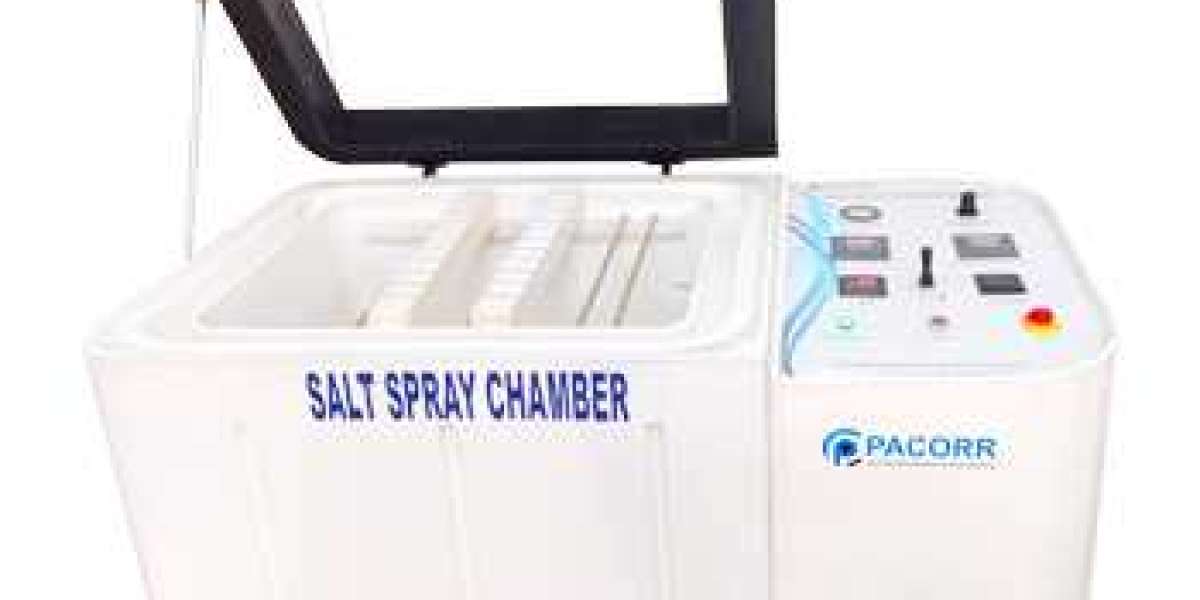Introduction
In the modern industrial landscape, ensuring the longevity and durability of products is crucial. One of the most significant factors that affect product life is corrosion. To combat this, manufacturers rely on advanced testing equipment like the Salt Spray Chamber. This article delves into the importance of Salt Spray Chambers, their functionality, and their application in various industries.
What is a Salt Spray Chamber?
A Salt Spray Test Chamber, also known as a Salt Fog Chamber, is a testing device used to evaluate the corrosion resistance of materials and coatings. By simulating a harsh, corrosive environment, it helps manufacturers determine how well their products can withstand prolonged exposure to saline conditions.
How Does a Salt Spray Chamber Work?
The primary function of a Corrosion Test Chamber is to create a controlled, corrosive environment. Here’s a step-by-step breakdown of its operation:
- Preparation: Samples are prepared and placed in the chamber.
- Saline Solution: A salt solution, typically sodium chloride, is prepared and atomized using a nozzle to create a fine mist.
- Exposure: The chamber maintains a constant temperature and humidity level, ensuring consistent exposure to the saline mist.
- Duration: Samples are exposed for a predetermined period, depending on the test requirements.
- Evaluation: After exposure, samples are evaluated for signs of corrosion, including rust, pitting, and blistering.
Key Features of a Salt Spray Chamber
- Controlled Environment: Ensures consistent and repeatable test conditions.
- Adjustable Parameters: Allows customization of temperature, humidity, and exposure time.
- Durable Construction: Made from corrosion-resistant materials to ensure long-term reliability.
- Easy Monitoring: Equipped with viewing windows and internal lighting for easy observation of the test process.
Applications of Salt Spray Chambers
Salt Spray Chambers are used across various industries to test the corrosion resistance of:
- Automotive Parts: To ensure the longevity of components like car bodies, frames, and fasteners.
- Coatings and Paints: To evaluate the effectiveness of protective coatings on metal surfaces.
- Marine Equipment: To test the durability of materials used in ships, boats, and offshore structures.
- Electronics: To assess the corrosion resistance of electronic components and housings.
Benefits of Using a Salt Spray Chamber
- Product Improvement: Helps in identifying potential weaknesses in materials and coatings, leading to better product designs.
- Quality Assurance: Ensures products meet industry standards and customer expectations for durability.
- Cost Savings: Prevents costly recalls and warranty claims by identifying issues before products reach the market.
- Regulatory Compliance: Helps manufacturers comply with international corrosion resistance standards.
Choosing the Right Salt Spray Chamber
When selecting a Salt Spray Chamber, consider the following factors:
- Chamber Size: Ensure it can accommodate your sample sizes.
- Test Standards: Verify that the chamber complies with relevant industry standards.
- Ease of Use: Look for features like intuitive controls and easy maintenance.
- Reliability: Choose a reputable manufacturer known for high-quality equipment.
Maintenance and Calibration
Regular maintenance and calibration are essential to ensure the accuracy and longevity of your Salt Spray Chamber. This includes:
- Cleaning: Regular cleaning of the chamber and nozzle to prevent blockages.
- Inspection: Routine checks for wear and tear on seals and gaskets.
- Calibration: Periodic calibration to maintain accurate test conditions.
Salt Spray Chambers are indispensable tools in the fight against corrosion. By providing a controlled environment to test materials and coatings, they help manufacturers ensure their products can withstand harsh conditions. Investing in a high-quality Salt Spray Chamber Price not only enhances product durability but also boosts customer satisfaction and brand reputation.
For more information on Salt Spray Chambers and other testing equipment, visit paccor.com. Explore our range of products designed to meet your industry’s stringent quality control requirements.
FAQ: Salt Spray Chamber
Q1: What is a Salt Spray Chamber used for?
A1: A Salt Spray Chamber is used to evaluate the corrosion resistance of materials and coatings by exposing them to a controlled, saline mist environment, simulating long-term exposure to corrosive conditions.
Q2: How does a Salt Spray Chamber work?
A2: The chamber creates a corrosive environment by atomizing a saline solution into a fine mist. Samples are placed in the chamber and exposed to this mist for a specified duration. The chamber maintains consistent temperature and humidity levels to ensure accurate test results.
Q3: What industries use Salt Spray Chambers?
A3: Industries such as automotive, marine, electronics, and coatings use Salt Spray Chambers to test the durability and corrosion resistance of their products and materials.
Q4: What standards are followed for salt spray testing?
A4: Common standards include ASTM B117, ISO 9227, and JIS Z 2371. These standards specify the procedures and requirements for conducting salt spray tests.
Q5: How long does a salt spray test typically take?
A5: The duration of a salt spray test can range from a few hours to several weeks, depending on the material being tested and the specific requirements of the test.
Q6: Can non-metallic materials be tested in a Salt Spray Chamber?
A6: Yes, while primarily used for metals, Salt Spray Chambers can also test the corrosion resistance of certain non-metallic materials and coatings.
Q7: How often should a Salt Spray Chamber be calibrated?
A7: It is recommended to calibrate the chamber at least once a year to ensure accurate and reliable test results.
Q8: What are the benefits of using a Salt Spray Chamber?
A8: Using a Salt Spray Test Chamber helps in identifying potential weaknesses in materials, improving product designs, ensuring quality assurance, preventing costly recalls, and complying with international corrosion resistance standards.
Q9: What factors should be considered when choosing a Salt Spray Chamber?
A9: Key factors include the chamber size, compliance with test standards, ease of use, and reliability of the manufacturer.
Q10: How is maintenance performed on a Salt Spray Chamber?
A10: Regular maintenance includes cleaning the chamber and nozzle, inspecting seals and gaskets for wear, and performing periodic calibrations to maintain accurate test conditions.
Q11: Are there different types of salt solutions used in Salt Spray Chambers?
A11: Yes, different salt solutions, such as sodium chloride and acetic acid, can be used depending on the specific test requirements and standards.
Q12: How can I ensure accurate results from my Salt Spray Chamber?
A12: Ensuring accurate results involves following proper test procedures, maintaining the chamber regularly, and calibrating the equipment annually.
About Salt Spray Chambers
Salt Spray Chambers, also known as Salt Fog Chambers, are essential tools in the field of corrosion testing. These devices simulate corrosive environments to test the durability and resistance of materials and coatings to prolonged exposure to saline conditions. Corrosion Test Chamber This type of testing is crucial for industries where products are exposed to harsh environments, such as automotive, marine, electronics, and coatings industries.
The Importance of Corrosion Testing
Corrosion can significantly impact the longevity and performance of products. By using Salt Spray Chambers, manufacturers can identify potential weaknesses in their materials and coatings, leading to improved product designs and higher quality standards. This testing helps ensure that products meet regulatory requirements and customer expectations for durability.
How Salt Spray Chambers Work
Salt Spray Chambers create a controlled environment where samples are exposed to a fine mist of saline solution. The key components and process include:
- Preparation: Samples are cleaned and placed inside the chamber on racks or holders.
- Saline Solution: A specific concentration of sodium chloride solution is prepared and atomized into a fine mist.
- Exposure: The chamber maintains a constant temperature and humidity level, typically around 35°C with 95% humidity, ensuring consistent exposure to the saline mist.
- Duration: Samples are exposed for a set duration, ranging from a few hours to several weeks, based on the test requirements.
- Evaluation: After exposure, samples are assessed for signs of corrosion, such as rust, pitting, and coating deterioration.
Key Features of Modern Salt Spray Chambers
- Precision Control: Modern chambers offer precise control over temperature, humidity, and mist concentration, ensuring accurate and repeatable test conditions.
- Robust Construction: Built with corrosion-resistant materials, these chambers are designed for long-term use.
- User-Friendly Interface: Advanced models come with digital displays and programmable controls for ease of operation.
- Observation Windows: Equipped with clear viewing windows and internal lighting to monitor the test process without opening the chamber.
- Compliance with Standards: Designed to meet international testing standards such as ASTM B117, ISO 9227, and JIS Z 2371.
Applications Across Industries
Salt Spray Chambers are widely used to test the corrosion resistance of:
- Automotive Components: To ensure the durability of car bodies, frames, and fasteners against road salt and other corrosive elements.
- Marine Equipment: To test the resistance of materials used in ships, boats, and offshore structures to saltwater environments.
- Electronic Housings: To assess the protection offered by coatings on electronic devices and components.
- Protective Coatings: To evaluate the effectiveness of paints, varnishes, and other coatings in protecting metal surfaces from corrosion.
Choosing the Right Salt Spray Chamber
When selecting a Salt Spray Chamber, consider the following:
- Size and Capacity: Ensure the chamber can accommodate your sample sizes and quantities.
- Compliance: Verify that the chamber meets the relevant industry standards for your tests.
- Features: Look for features that enhance usability, such as digital controls, programmable settings, and easy maintenance.
- Manufacturer Reputation: Choose a reputable manufacturer known for high-quality and reliable testing equipment.
Maintenance and Calibration
Regular maintenance and calibration are crucial to the accuracy and longevity of a Salt Spray Chamber. Key maintenance tasks include:
- Cleaning: Regularly clean the chamber interior, nozzles, and solution reservoir to prevent salt build-up and blockages.
- Inspection: Check seals, gaskets, and other components for wear and tear.
- Calibration: Perform annual calibrations to ensure the chamber's environmental conditions are accurate and consistent.
Conclusion
Investing in a high-quality Salt Spray Chamber is essential for manufacturers committed to ensuring the durability and reliability of their products. By providing a rigorous testing environment, these chambers help identify potential issues early in the design process, leading to better products and higher customer satisfaction.
For more detailed information on Salt Spray Chambers and other advanced testing equipment, visit Pacorr Testing Instruments. Our comprehensive range of products is designed to meet the stringent quality control needs of various industries, ensuring your products are built to last.


